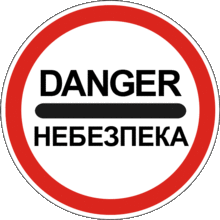Hazard
A hazard is a situation that poses a level of threat to life, health, property, or environment. Hazards can be dormant or potential, with only a theoretical risk of harm; however, once a hazard becomes "active", it can create an emergency. A hazardous situation that has come to pass is called an incident. Hazard and possibility interact together to create risk.[1]
Identification of hazard risks is the first step in performing a risk assessment.
Modes of a hazard


Hazards are sometimes classified into three modes:[2]
- Dormant—The situation environment is currently affected. For instance, a hillside may be unstable, with the potential for a landslide, but there is nothing below or on the hillside that could be affected.
- Armed—People, property, or environment are in potential harm's way.
- Active—A harmful incident involving the hazard has actually occurred. Often this is referred to not as an "active hazard" but as an accident, emergency, incident, or disaster.
Types of hazard
Hazards are generally labeled as one of five types
- Physical hazards are conditions or situations that can cause the body physical harm or intense stress. Physical hazards can be both natural and human made elements.
- Chemical hazards are substances that can cause harm or damage to the body, property or the environment. Chemical hazards can be both natural or human made origin.
- Biological hazards are biological agents that can cause harm to the human body. Some biological agents can be viruses, parasites, bacteria, food, fungi, and foreign toxins.
- Psychological hazards are created during work related stress or a stressful environment.A person can be a hazard when he/she is affected psychological disturbance through -stress,shift patterns and also can be a hazard when a person is under the influence of alcohol,illness and lack of training.
- Ergonomic Hazard
By its nature, a hazard involves something that could potentially be harmful to a person's life, health, property, or the environment. One key concept in identifying a hazard is the presence of stored energy that, when released, can cause damage. Stored energy can occur in many forms: chemical, mechanical, thermal, radioactive, electrical, etc. Another class of hazard does not involve release of stored energy, rather it involves the presence of hazardous situations. Examples include confined or limited egress spaces, oxygen-depleted atmospheres, awkward positions, repetitive motions, low-hanging or protruding objects, etc.
There are several methods of classifying hazard, but most systems use some variation on the factors of "likelihood" of the hazard turning into an incident and the "seriousness" of the incident if it were to occur. (This discussion moved away from hazard to a discussion of risk.)
A common method is to score both likelihood and seriousness on a numerical scale (with the most likely and most serious scoring highest) and multiplying one by the other to produce a comparative score.
Risk = Hazard × Vulnerability / Capacity
This score identifies hazards that require mitigation. A low score on likelihood of occurrence may mean that the hazard is dormant, whereas a high score indicates it may be an "active" hazard.
An important component of "seriousness if incident occurred" is "serious to whom?" Different populations may be affected differently by accidents. For example, an explosion has widely differing effects on different populations, depending on the distance from the explosion. These possible effects range from death from overpressure or shrapnel, to inhalation of noxious gases (for people downwind), to exposure to a loud noise.
Prioritization of hazards
Hazards can be identified and prioritized using the SMUG model. The SMUG model provides a means for prioritizing hazards based on the risk they present during an emergency. The SMUG model stands for Seriousness, Manageability, Urgency, Growth.
References
- ↑ "a subjective concept that refers to the possibility of the circumstances under which the matter, field, information, energy, or all may influence the complex system, it would lead to consequences that are, or valued stakeholders (at the level of thinking, feeling or instinct) at a certain stage of development of the perceiver as negative". Zalatynskyi Vasyl Danger - a subjective evaluation of objective reality. Science & Military. – L. Mikulas, Slovak Republik. Armed Forces Academy of General Milan Rastislav Stefanik. No 1, Volume 8, 2013. P. 53-62 EV 2061/08, ISSN 1336-8885
- ↑ David MacCollum (December 18, 2006). Construction Safety Engineering Principles: Designing and Managing Safer Job Sites. McGraw-Hill Professional. ISBN 978-0-07-148244-8. Retrieved 2010-07-10.